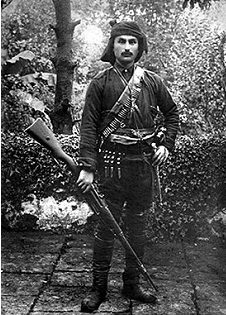Situated in the upper valley of the Halys (Kızılırmak), the area of the Ottoman kaza historically belonged to Lesser Armenia (Armenia Minor).
Traversed by the road leading from Sivas to Erzurum, the administrative seat Zara was mainly a farming town, but it also served as a way-station, with an immense khan that belonged to the Chil Hovhannesians.[1]
Toponym
Koçgirî (Kurdish قۆچگری/Qoçgirî; “emigrants”) or also Eşireta Qoçgirî is a former Kurmanji and Zazaki speaking tribal confederation. The toponym is composed of the Kurdish word ‘koç’ (emigration) and the suffix -gir/-kir (participle of take/undertake, i.e., undertaken).
Population
Armenian population figures differ by a factor of at least 2. According to some Armenian sources, before the 1915 genocide there lived 16,600 Armenians in the settlements of Alakilise, Zara, Gavak, Karaboğaz, Miatun, Chaykurd, Karhat, Kechayurd, together with Kurds, Turks and Greeks.[2] Based on the census of the Armenian Patriarchate in Constantinople, Raymond Kévorkian puts the total number of Armenians in the Koçgiri kaza at 7,651. The principal town of the kaza, Zara, had a total population of 6,000 inhabitants, 3,000 of them being Armenians. They lived in 9 localities, maintaining 10 churches.[3]
The Koçgiri tribal confederation owned 190 villages with 140,000 inhabitants in the Sivas area.
Greek settlements (Empes – Epesios region)
Αρμούττσαϊρι – Armoutsairi
Γκιόβτεπε – Giovtepe
Γούρμπαγι – Gourpagi
Ζάρα – Zara
Ίνοϊ – Inoi
Καγιάντιπι – Kayiantipi
Κανλίκαγια – Kanlikayia
Κιζίκ – Kizik
Οβατζούκ – Ovatzouk
Μουρασούλ – Mourasoul
Ντερένταμ (ή Ποντζουχλού) – Derentam (or Pontzoukhlou)
Ντερέκιοϊ (Σερεφιέ) – Dereköy (Serfiye)
Παζάρπελεν – Pazarpelen
Παναγία – Panayia
Πάσονος (ή Κούλαλι) – Pasonos (or Koulali)
Τσελέπ – Tselep
Τσαμλίκαλε (Τσαμλίγαλα) – Tsamlikalle (Tsamligala)
Τσιτορέν – Tsitoren (4)
Destruction
During the First World War
As early as 2 April 1915, a battalion of Special Organization bandits, formed at the initiative of Governor Muammer and commanded by Kütükoğlu Hüseyin and Zaralı Mahir (‘Mahir from Zara’), proceeded to arrest the priests, teachers and notables excused from conscription in the Armenian villages in the valley of Kızılırmak (Grk.: Halys). Some of these prisoners were executed in the gorges of Seyfe, while the others were interned at Sivas.
Between 20 and 29 June 1915 around 7,000 Armenians of the kaza Koçgiri were deported to Divriği, then Harput, Siverek, Urfa, Viranhşehir, and Rakka.[5]
Arrests and imprisonment in Zara, killings of men and deportation of the rest of the population also affected the Greek Orthodox population of the kazas of Koçgiri and Şebinkarahisar.
… what happened in that part of Epesios, and especially in the villages higher up the mountain, is indescribable. Mourning and tears and wailing. Beatings, pillaging, abductions, rapes, kidnapping, burning, strangling and general mistreatment. After sating their savage thirst in whatever way they could, these monsters gathered together in the central square all those souls who had survived thanks merely to the carelessness of the victors. There the males between the ages of 10 and 70 were separated from the women and, at bayonet point, were led away by the monsters to the commander of the district; a brief interrogation followed, in the course of which people from other villages were also charged with aiding and abetting the rebels, thus leading to new arrests and torment. The total number of incarcerated men of different ages and backgrounds came to 600 in total. Their conditions of imprisonment were wretched, being damp, dingy basements in Zara and where, following merciless beatings, hunger (three days without bread or water) and asphyxiation due to up to 60 people being locked in a tiny room together, the first victims finally succumbed. The survivors of this ordeal were taken to a court martial at Sivas, where new victims died. In short, in one year, out of the 600 men it would not be an exaggeration to say that only 20 survived, and those only by sheer luck….
In the meantime, the women and children had their property and belongings expropriated and were escorted by savage gendarmes to Aziziye, a far-off place of banishment, where groups of between five and ten women were sent to Turkish villages to be converted to Islam. But few of these survived, most dying on the way or in the villages themselves.
The general plight of our region was indeed never worse. Fear and terror possessed everyone, who awaited their extermination at every moment….
No-one dared to leave his home or village for fear of falling victim to the savagery and fanaticism raging outside. Restricted to their homes, with no work or other means, many died of starvation.[6]
In the Epesios [Empes] area, 18 villages were forced by the Turkish authorities to abandon their cultivations under threat of death.[7]
Under the Kemalists
G. Valavanis wrote on the Kurdish mission and the murder of Greeks in the kaza of Koçgiri (Zara) and adjacent areas:

“In May 1921, the Ankara government sent Topal Osman a telegram in which they ordered him to take his çeteler and set out immediately for the Zara district, where he was to join the bloodthirsty general Nureddin Pasha, who had already started against the Kurds of Zara with an army of eight thousand. As is too often the case with irregular fighters and despite their bravery, the Kurds did not manage to resist the regular Turkish force; the fate of that revolt was determined from the first battle… Before Osman Ağa moved against the Kurds, he was staying at Refahiye [Kurdish: Gercan, Armenian: Կերճանիս Gercanis)]; as soon as he received orders to join Nureddin, he moved on to Suşehir. There, in the presence of the mutesarrıf of Karahisar, he had all Christians assembled close to the administration building and shot; he then left for Kalehisar, where he had 62 Greek prisoners butchered. Among them were 14 deportees of varied origin; most of them were intellectuals. Instead of heading to Me[h]sudiye [Mahsudiye], Osman Ağa went to Reşadiye [Sancak Tokat] and Niksar; destroying and murdering on the way, he finally arrived at Erbaa, where he had the 700 Greeks imprisoned there savagely butchered.”[8]